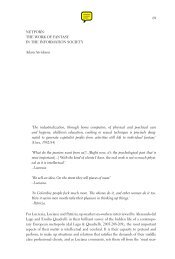Nakamura, Digitizing Race, Introduction, chapter 5, Epilogue
Nakamura, Digitizing Race, Introduction, chapter 5, Epilogue
Nakamura, Digitizing Race, Introduction, chapter 5, Epilogue
You also want an ePaper? Increase the reach of your titles
YUMPU automatically turns print PDFs into web optimized ePapers that Google loves.
66 “Ramadan Is Almoast Here!”<br />
ones, and like them, their subject is a female body that is optimized for<br />
viewing. The visual culture of these buddies governs the gaze to take in<br />
tiny images of curvy “dollz,” digibodies that are flirtatiously revealed to the<br />
user as a series of slides that unveil the body’s parts in sequence. This breaking<br />
up or partitioning of the female body into pieces to be put on separate<br />
slides invokes a way of looking that constructs the female digital body as a<br />
fetish. 27 As Mary Flanagan writes: “The role of fetishism, particularly the<br />
fetishization of the woman, in digital media is of great interest to any critical<br />
understandings of this new landscape, for digibodies are created from<br />
discrete elements and are positioned within a command and control paradigm<br />
of desire. Thus what is proposed here is that the means of this particular<br />
kind of 3D artifact production allows the body to be thought of as segmented<br />
and zoned. This breaking up of the female body into discrete elements,<br />
i.e. the creation of the image of woman as series of objects, is in<br />
terms of fetishistic scopophilia, focusing on the object or body part used for<br />
sexual enjoyment.” 28 As does Manovich, Flanagan stresses the modular independence<br />
of the individual digital parts that make up digibodies and all new<br />
media objects, but unlike him, she identifies a “command and control paradigm<br />
of desire” that expresses an overdetermined female body that works as a<br />
site of visual pleasure in Western culture. Thus “independence” on the level<br />
of the image’s structure and function results in a dynamic in which independence<br />
in political and representational terms is withheld from women<br />
themselves. Animated GIF AIM buddies of women’s bodies or “dollz” employ<br />
this scopophilic mode of envisioning, virtually panning down the<br />
female body to represent it in parts, mimicking the surveying gaze of a spectator<br />
who “checks out” female bodies in the world. The sequence of images<br />
representing a face, a curvaceous torso, and a pair of feet repeat to imitate a<br />
stereotypically masculine gaze. As Roland Barthes writes in his dissection of<br />
the dynamics of looking embodied in striptease: “There will therefore be in<br />
striptease a whole series of coverings placed upon the body in proportion as<br />
she pretends to strip it bare.” 29 In the case of the “Muslim” buddy icon in<br />
particular, the form of the animated GIF and its pan down the virtual female<br />
body accomplish a kind of virtual striptease, an unveiling of the veiled body<br />
in the very act of asserting its own religious difference. The insertion of messages,<br />
slogans, flags, and other nonbodily signs alternates with this visual trail<br />
down the female avatar body, valencing it in political, religious, and national<br />
terms that assert key differences between these bodies despite their shared<br />
means of digital exhibition. Thus the position of the viewer is inherently a<br />
fetishistic one, one in which AIM buddy female bodies are both fetishes and





